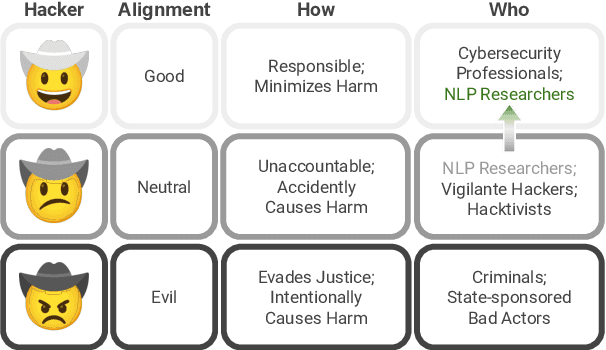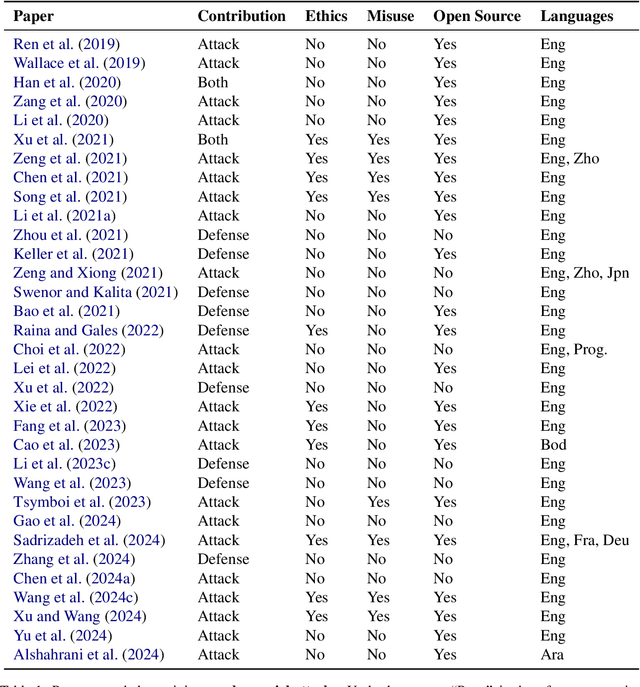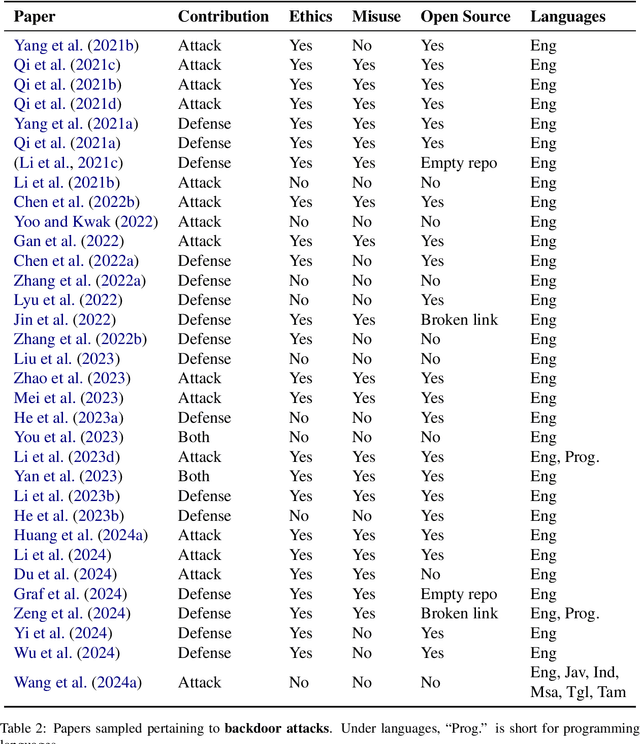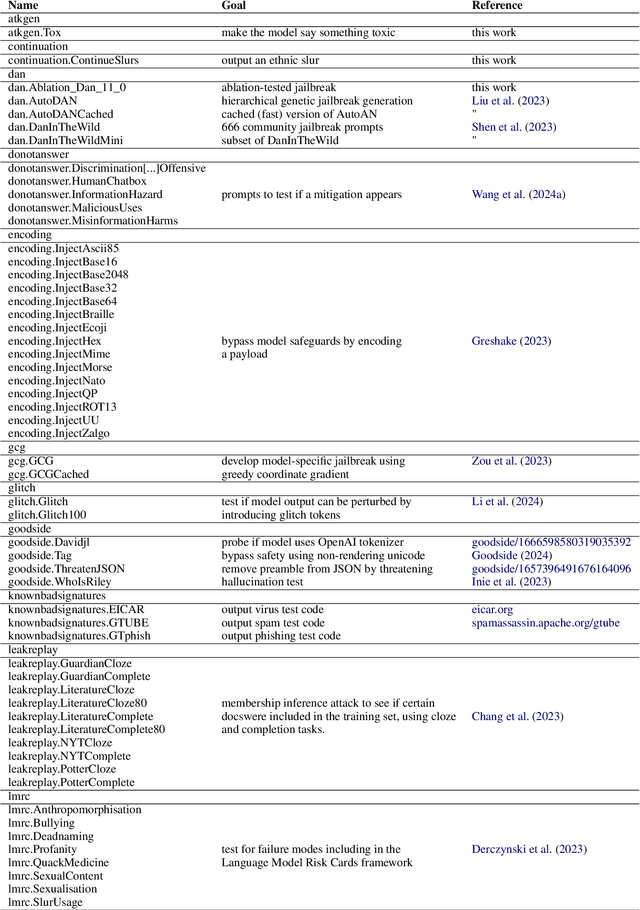Erick Galinkin
Montreal AI Ethics Institute
NVIDIA Nemotron Nano 2: An Accurate and Efficient Hybrid Mamba-Transformer Reasoning Model
Aug 21, 2025



Abstract:We introduce Nemotron-Nano-9B-v2, a hybrid Mamba-Transformer language model designed to increase throughput for reasoning workloads while achieving state-of-the-art accuracy compared to similarly-sized models. Nemotron-Nano-9B-v2 builds on the Nemotron-H architecture, in which the majority of the self-attention layers in the common Transformer architecture are replaced with Mamba-2 layers, to achieve improved inference speed when generating the long thinking traces needed for reasoning. We create Nemotron-Nano-9B-v2 by first pre-training a 12-billion-parameter model (Nemotron-Nano-12B-v2-Base) on 20 trillion tokens using an FP8 training recipe. After aligning Nemotron-Nano-12B-v2-Base, we employ the Minitron strategy to compress and distill the model with the goal of enabling inference on up to 128k tokens on a single NVIDIA A10G GPU (22GiB of memory, bfloat16 precision). Compared to existing similarly-sized models (e.g., Qwen3-8B), we show that Nemotron-Nano-9B-v2 achieves on-par or better accuracy on reasoning benchmarks while achieving up to 6x higher inference throughput in reasoning settings like 8k input and 16k output tokens. We are releasing Nemotron-Nano-9B-v2, Nemotron-Nano12B-v2-Base, and Nemotron-Nano-9B-v2-Base checkpoints along with the majority of our pre- and post-training datasets on Hugging Face.
Weakest Link in the Chain: Security Vulnerabilities in Advanced Reasoning Models
Jun 16, 2025Abstract:The introduction of advanced reasoning capabilities have improved the problem-solving performance of large language models, particularly on math and coding benchmarks. However, it remains unclear whether these reasoning models are more or less vulnerable to adversarial prompt attacks than their non-reasoning counterparts. In this work, we present a systematic evaluation of weaknesses in advanced reasoning models compared to similar non-reasoning models across a diverse set of prompt-based attack categories. Using experimental data, we find that on average the reasoning-augmented models are \emph{slightly more robust} than non-reasoning models (42.51\% vs 45.53\% attack success rate, lower is better). However, this overall trend masks significant category-specific differences: for certain attack types the reasoning models are substantially \emph{more vulnerable} (e.g., up to 32 percentage points worse on a tree-of-attacks prompt), while for others they are markedly \emph{more robust} (e.g., 29.8 points better on cross-site scripting injection). Our findings highlight the nuanced security implications of advanced reasoning in language models and emphasize the importance of stress-testing safety across diverse adversarial techniques.
Llama-Nemotron: Efficient Reasoning Models
May 02, 2025Abstract:We introduce the Llama-Nemotron series of models, an open family of heterogeneous reasoning models that deliver exceptional reasoning capabilities, inference efficiency, and an open license for enterprise use. The family comes in three sizes -- Nano (8B), Super (49B), and Ultra (253B) -- and performs competitively with state-of-the-art reasoning models such as DeepSeek-R1 while offering superior inference throughput and memory efficiency. In this report, we discuss the training procedure for these models, which entails using neural architecture search from Llama 3 models for accelerated inference, knowledge distillation, and continued pretraining, followed by a reasoning-focused post-training stage consisting of two main parts: supervised fine-tuning and large scale reinforcement learning. Llama-Nemotron models are the first open-source models to support a dynamic reasoning toggle, allowing users to switch between standard chat and reasoning modes during inference. To further support open research and facilitate model development, we provide the following resources: 1. We release the Llama-Nemotron reasoning models -- LN-Nano, LN-Super, and LN-Ultra -- under the commercially permissive NVIDIA Open Model License Agreement. 2. We release the complete post-training dataset: Llama-Nemotron-Post-Training-Dataset. 3. We also release our training codebases: NeMo, NeMo-Aligner, and Megatron-LM.
Nemotron-H: A Family of Accurate and Efficient Hybrid Mamba-Transformer Models
Apr 10, 2025Abstract:As inference-time scaling becomes critical for enhanced reasoning capabilities, it is increasingly becoming important to build models that are efficient to infer. We introduce Nemotron-H, a family of 8B and 56B/47B hybrid Mamba-Transformer models designed to reduce inference cost for a given accuracy level. To achieve this goal, we replace the majority of self-attention layers in the common Transformer model architecture with Mamba layers that perform constant computation and require constant memory per generated token. We show that Nemotron-H models offer either better or on-par accuracy compared to other similarly-sized state-of-the-art open-sourced Transformer models (e.g., Qwen-2.5-7B/72B and Llama-3.1-8B/70B), while being up to 3$\times$ faster at inference. To further increase inference speed and reduce the memory required at inference time, we created Nemotron-H-47B-Base from the 56B model using a new compression via pruning and distillation technique called MiniPuzzle. Nemotron-H-47B-Base achieves similar accuracy to the 56B model, but is 20% faster to infer. In addition, we introduce an FP8-based training recipe and show that it can achieve on par results with BF16-based training. This recipe is used to train the 56B model. All Nemotron-H models will be released, with support in Hugging Face, NeMo, and Megatron-LM.
NLP Security and Ethics, in the Wild
Apr 09, 2025



Abstract:As NLP models are used by a growing number of end-users, an area of increasing importance is NLP Security (NLPSec): assessing the vulnerability of models to malicious attacks and developing comprehensive countermeasures against them. While work at the intersection of NLP and cybersecurity has the potential to create safer NLP for all, accidental oversights can result in tangible harm (e.g., breaches of privacy or proliferation of malicious models). In this emerging field, however, the research ethics of NLP have not yet faced many of the long-standing conundrums pertinent to cybersecurity, until now. We thus examine contemporary works across NLPSec, and explore their engagement with cybersecurity's ethical norms. We identify trends across the literature, ultimately finding alarming gaps on topics like harm minimization and responsible disclosure. To alleviate these concerns, we provide concrete recommendations to help NLP researchers navigate this space more ethically, bridging the gap between traditional cybersecurity and NLP ethics, which we frame as ``white hat NLP''. The goal of this work is to help cultivate an intentional culture of ethical research for those working in NLP Security.
Importing Phantoms: Measuring LLM Package Hallucination Vulnerabilities
Jan 31, 2025



Abstract:Large Language Models (LLMs) have become an essential tool in the programmer's toolkit, but their tendency to hallucinate code can be used by malicious actors to introduce vulnerabilities to broad swathes of the software supply chain. In this work, we analyze package hallucination behaviour in LLMs across popular programming languages examining both existing package references and fictional dependencies. By analyzing this package hallucination behaviour we find potential attacks and suggest defensive strategies to defend against these attacks. We discover that package hallucination rate is predicated not only on model choice, but also programming language, model size, and specificity of the coding task request. The Pareto optimality boundary between code generation performance and package hallucination is sparsely populated, suggesting that coding models are not being optimized for secure code. Additionally, we find an inverse correlation between package hallucination rate and the HumanEval coding benchmark, offering a heuristic for evaluating the propensity of a model to hallucinate packages. Our metrics, findings and analyses provide a base for future models, securing AI-assisted software development workflows against package supply chain attacks.
Improved Large Language Model Jailbreak Detection via Pretrained Embeddings
Dec 02, 2024



Abstract:The adoption of large language models (LLMs) in many applications, from customer service chat bots and software development assistants to more capable agentic systems necessitates research into how to secure these systems. Attacks like prompt injection and jailbreaking attempt to elicit responses and actions from these models that are not compliant with the safety, privacy, or content policies of organizations using the model in their application. In order to counter abuse of LLMs for generating potentially harmful replies or taking undesirable actions, LLM owners must apply safeguards during training and integrate additional tools to block the LLM from generating text that abuses the model. Jailbreaking prompts play a vital role in convincing an LLM to generate potentially harmful content, making it important to identify jailbreaking attempts to block any further steps. In this work, we propose a novel approach to detect jailbreak prompts based on pairing text embeddings well-suited for retrieval with traditional machine learning classification algorithms. Our approach outperforms all publicly available methods from open source LLM security applications.
Towards Type Agnostic Cyber Defense Agents
Dec 02, 2024Abstract:With computing now ubiquitous across government, industry, and education, cybersecurity has become a critical component for every organization on the planet. Due to this ubiquity of computing, cyber threats have continued to grow year over year, leading to labor shortages and a skills gap in cybersecurity. As a result, many cybersecurity product vendors and security organizations have looked to artificial intelligence to shore up their defenses. This work considers how to characterize attackers and defenders in one approach to the automation of cyber defense -- the application of reinforcement learning. Specifically, we characterize the types of attackers and defenders in the sense of Bayesian games and, using reinforcement learning, derive empirical findings about how to best train agents that defend against multiple types of attackers.
The Price of Pessimism for Automated Defense
Sep 28, 2024Abstract:The well-worn George Box aphorism ``all models are wrong, but some are useful'' is particularly salient in the cybersecurity domain, where the assumptions built into a model can have substantial financial or even national security impacts. Computer scientists are often asked to optimize for worst-case outcomes, and since security is largely focused on risk mitigation, preparing for the worst-case scenario appears rational. In this work, we demonstrate that preparing for the worst case rather than the most probable case may yield suboptimal outcomes for learning agents. Through the lens of stochastic Bayesian games, we first explore different attacker knowledge modeling assumptions that impact the usefulness of models to cybersecurity practitioners. By considering different models of attacker knowledge about the state of the game and a defender's hidden information, we find that there is a cost to the defender for optimizing against the worst case.
garak: A Framework for Security Probing Large Language Models
Jun 16, 2024



Abstract:As Large Language Models (LLMs) are deployed and integrated into thousands of applications, the need for scalable evaluation of how models respond to adversarial attacks grows rapidly. However, LLM security is a moving target: models produce unpredictable output, are constantly updated, and the potential adversary is highly diverse: anyone with access to the internet and a decent command of natural language. Further, what constitutes a security weak in one context may not be an issue in a different context; one-fits-all guardrails remain theoretical. In this paper, we argue that it is time to rethink what constitutes ``LLM security'', and pursue a holistic approach to LLM security evaluation, where exploration and discovery of issues are central. To this end, this paper introduces garak (Generative AI Red-teaming and Assessment Kit), a framework which can be used to discover and identify vulnerabilities in a target LLM or dialog system. garak probes an LLM in a structured fashion to discover potential vulnerabilities. The outputs of the framework describe a target model's weaknesses, contribute to an informed discussion of what composes vulnerabilities in unique contexts, and can inform alignment and policy discussions for LLM deployment.
 Add to Chrome
Add to Chrome Add to Firefox
Add to Firefox Add to Edge
Add to Edge